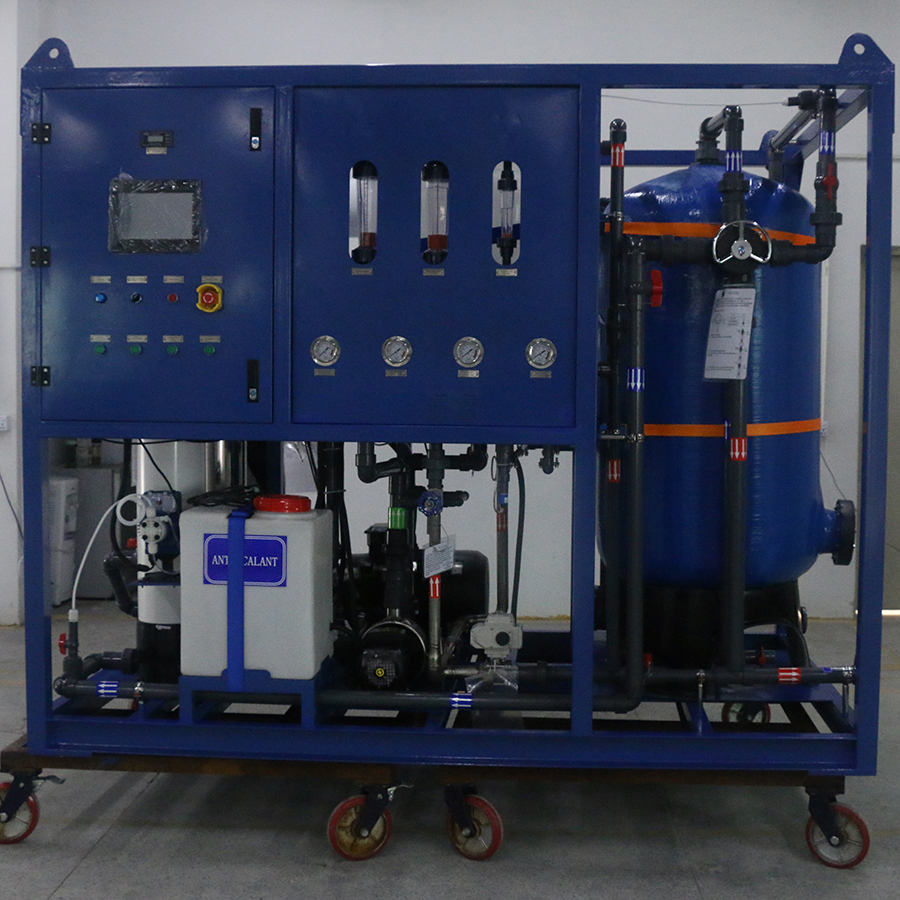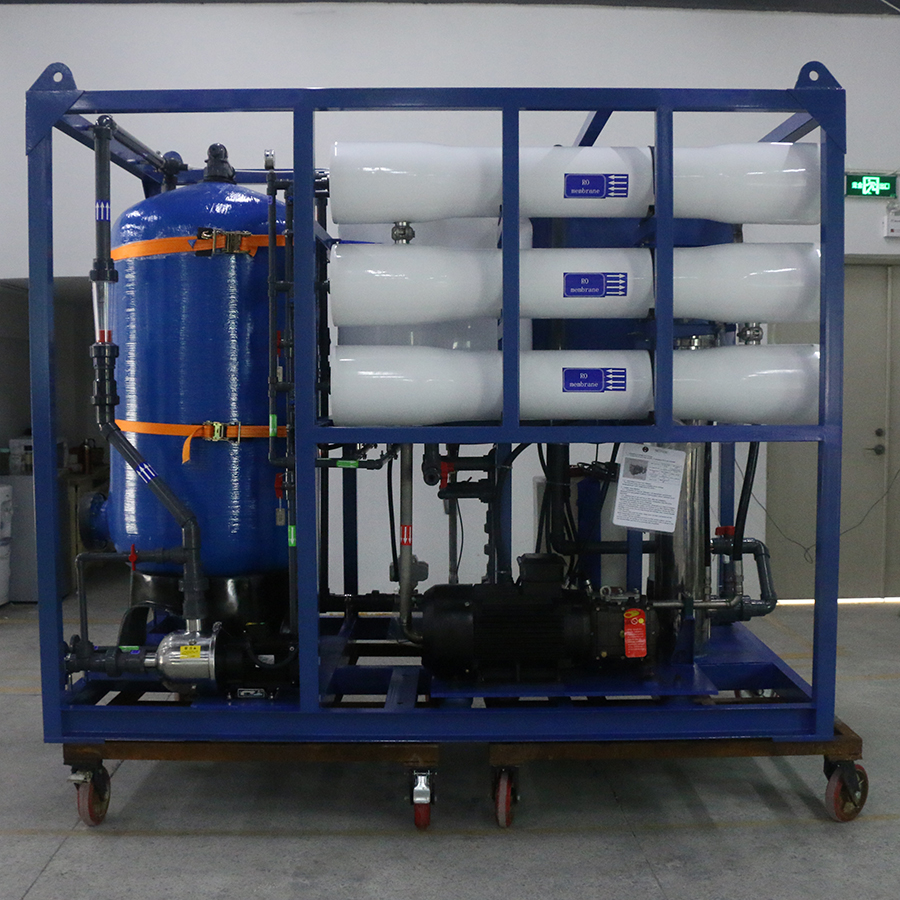07 Oct 2022
The process of seawater desalination by reverse osmosis
Desalination refers to the technology and process of obtaining fresh water from sea water. There are many types of seawater desalination technologies, including distillation method, membrane method (reverse osmosis, electrodialysis membrane evaporation, etc.), ion exchange method, etc., but the methods suitable for large-scale seawater desalination are only distillation method and reverse osmosis method.
The following will give you a detailed introduction to the process of seawater desalination using reverse osmosis.

1. Seawater sterilization and algae killing
Due to the presence of a large number of microorganisms, bacteria and algae in seawater. The reproduction of bacteria and algae and the growth of microorganisms in seawater will not only bring a lot of trouble to the water intake facilities, but also directly affect the normal operation of seawater desalination equipment and process pipelines. Therefore, the addition of liquid chlorine, sodium hypochlorite and copper sulfate is often used in seawater desalination projects. and other chemical agents to sterilize and kill algae.
2. Coagulation filtration
In order to further improve the influent water quality of reverse osmosis and reduce the turbidity of the influent water, a multi-media filter is usually added after coagulation filtration, so that the tiny suspended solids and particulate matter in the water can be further removed to ensure the further improvement of the water quality. improve.
3. Antiscalants and reducing agents
The composition of seawater is very complex, and the hardness and alkalinity are very high. In order to make the reverse osmosis system work better and keep the system running without scaling, it is necessary to add corresponding antiscalants according to the specific water quality. . In addition, because the oxidant is added in the reverse osmosis pretreatment for sterilization, it is necessary to add a reducing agent to reduce the reverse osmosis influent water, so that the residual chlorine in the influent water of the reverse osmosis system is less than 0.1ppm (or ORP<200mV), which satisfies the reverse osmosis system. The requirements of the osmotic system for the content of oxidizing substances in the influent water.
4. Security filter
Because the salt content of seawater is very high, the security filter is required to be made of 316L material, and the pore diameter of the filter element is usually 5μm, to filter the seawater before the high-pressure pump, block the particles larger than 5μm in diameter in the seawater, and ensure the high-pressure pump, energy recovery device and reverse osmosis. Membrane element safe, long-term stable operation.

5. High pressure pump and energy recovery device
High-pressure pump and energy recovery device are important equipment to provide energy conversion and energy saving for reverse osmosis seawater desalination equipment. According to the flow and pressure required by reverse osmosis seawater desalination equipment, the energy recovery device has a hydraulic turbine structure and can utilize reverse osmosis. The pressure of the discharged concentrated seawater increases the reverse osmosis influent pressure by 30%, so that the energy of the concentrated water can be effectively utilized, while reducing energy consumption, thereby effectively reducing operating costs.
6. Reverse osmosis components and devices
The reverse osmosis membrane element is the core component of the reverse osmosis seawater desalination equipment. The seawater desalination membrane corresponding to the seawater desalination equipment system should be selected. According to the different design of the system, different membrane elements can be selected. The reverse osmosis membrane element has a high desalination rate. Good pressure resistance, anti-oxidation and anti-pollution properties. The material of the seawater desalination reverse osmosis equipment system should be made of stainless steel above 316L in the high-pressure part to prevent the corrosion of the high-pressure pipeline due to the high salt content of seawater.
7. System control
The control system of the reverse osmosis seawater desalination equipment usually adopts the programmable controller PLC to form a decentralized sampling control and centralized monitoring and operation control system. Set high and low pressure protection switches and automatic switching devices according to process parameters. When the conductance, flow and pressure are abnormal, automatic switching, automatic interlocking alarm, and shutdown can be realized to protect the high-pressure pump and reverse osmosis membrane elements. The start and stop of the high-pressure pump are controlled by frequency conversion to realize the soft operation of the high-pressure pump, save energy consumption, and prevent the damage of the high-pressure pump and membrane elements due to water hammer or back pressure. The program is designed to realize low-pressure automatic flushing before and after the reverse osmosis unit starts and stops. Especially during the shutdown, the metastable state of concentrated seawater will transform into precipitation, pollute the membrane surface, and the automatic flushing of low-pressure desalinated water can replace concentrated seawater and protect the The membrane surface is not polluted, extending the service life of the membrane. The system temperature, flow, water quality, water production and other related parameters can be displayed, stored, counted, tabulated and printed. The dynamic process flow picture in the monitoring operation is clear and intuitive, and the system control simplifies the manual operation to ensure that the system can operate automatically, safely and reliably.
For more details, please call the contact us or log on to the official website of Guangdong Stark Water Treatment Co., Ltd. https://www.stark-water.com/ for consultation.
The following will give you a detailed introduction to the process of seawater desalination using reverse osmosis.

1. Seawater sterilization and algae killing
Due to the presence of a large number of microorganisms, bacteria and algae in seawater. The reproduction of bacteria and algae and the growth of microorganisms in seawater will not only bring a lot of trouble to the water intake facilities, but also directly affect the normal operation of seawater desalination equipment and process pipelines. Therefore, the addition of liquid chlorine, sodium hypochlorite and copper sulfate is often used in seawater desalination projects. and other chemical agents to sterilize and kill algae.
2. Coagulation filtration
In order to further improve the influent water quality of reverse osmosis and reduce the turbidity of the influent water, a multi-media filter is usually added after coagulation filtration, so that the tiny suspended solids and particulate matter in the water can be further removed to ensure the further improvement of the water quality. improve.
3. Antiscalants and reducing agents
The composition of seawater is very complex, and the hardness and alkalinity are very high. In order to make the reverse osmosis system work better and keep the system running without scaling, it is necessary to add corresponding antiscalants according to the specific water quality. . In addition, because the oxidant is added in the reverse osmosis pretreatment for sterilization, it is necessary to add a reducing agent to reduce the reverse osmosis influent water, so that the residual chlorine in the influent water of the reverse osmosis system is less than 0.1ppm (or ORP<200mV), which satisfies the reverse osmosis system. The requirements of the osmotic system for the content of oxidizing substances in the influent water.
4. Security filter
Because the salt content of seawater is very high, the security filter is required to be made of 316L material, and the pore diameter of the filter element is usually 5μm, to filter the seawater before the high-pressure pump, block the particles larger than 5μm in diameter in the seawater, and ensure the high-pressure pump, energy recovery device and reverse osmosis. Membrane element safe, long-term stable operation.

5. High pressure pump and energy recovery device
High-pressure pump and energy recovery device are important equipment to provide energy conversion and energy saving for reverse osmosis seawater desalination equipment. According to the flow and pressure required by reverse osmosis seawater desalination equipment, the energy recovery device has a hydraulic turbine structure and can utilize reverse osmosis. The pressure of the discharged concentrated seawater increases the reverse osmosis influent pressure by 30%, so that the energy of the concentrated water can be effectively utilized, while reducing energy consumption, thereby effectively reducing operating costs.
6. Reverse osmosis components and devices
The reverse osmosis membrane element is the core component of the reverse osmosis seawater desalination equipment. The seawater desalination membrane corresponding to the seawater desalination equipment system should be selected. According to the different design of the system, different membrane elements can be selected. The reverse osmosis membrane element has a high desalination rate. Good pressure resistance, anti-oxidation and anti-pollution properties. The material of the seawater desalination reverse osmosis equipment system should be made of stainless steel above 316L in the high-pressure part to prevent the corrosion of the high-pressure pipeline due to the high salt content of seawater.
7. System control
The control system of the reverse osmosis seawater desalination equipment usually adopts the programmable controller PLC to form a decentralized sampling control and centralized monitoring and operation control system. Set high and low pressure protection switches and automatic switching devices according to process parameters. When the conductance, flow and pressure are abnormal, automatic switching, automatic interlocking alarm, and shutdown can be realized to protect the high-pressure pump and reverse osmosis membrane elements. The start and stop of the high-pressure pump are controlled by frequency conversion to realize the soft operation of the high-pressure pump, save energy consumption, and prevent the damage of the high-pressure pump and membrane elements due to water hammer or back pressure. The program is designed to realize low-pressure automatic flushing before and after the reverse osmosis unit starts and stops. Especially during the shutdown, the metastable state of concentrated seawater will transform into precipitation, pollute the membrane surface, and the automatic flushing of low-pressure desalinated water can replace concentrated seawater and protect the The membrane surface is not polluted, extending the service life of the membrane. The system temperature, flow, water quality, water production and other related parameters can be displayed, stored, counted, tabulated and printed. The dynamic process flow picture in the monitoring operation is clear and intuitive, and the system control simplifies the manual operation to ensure that the system can operate automatically, safely and reliably.
For more details, please call the contact us or log on to the official website of Guangdong Stark Water Treatment Co., Ltd. https://www.stark-water.com/ for consultation.